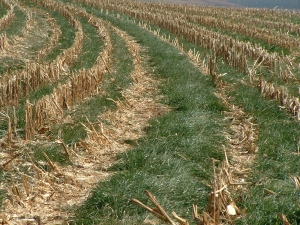Grant Description
The Alliance to Advance Climate-Smart Agriculture is a pilot program funded by the USDA’s Partnerships for Climate-Smart Commodities that will incentivize and reward farmers and ranchers for adopting climate-smart agricultural practices. It will also undertake research and collect producer and stakeholder feedback to generate guidance for a federal program that could reach all producers in the U.S. Four states are participating: Arkansas, Minnesota, North Dakota, and Virginia. The Virginia Tech College of Agriculture and Life Sciences is administering the project, with participation from each state and many additional partners.
The participating SWCDs in Minnesota are:
- East Otter Tail and Wadena
- Fillmore and Root River (Houston)
- Kandiyohi
- Redwood
- Renville
- Stevens
Landowners and operators in those counties can apply to participate in this pilot during an initial application period from July 15 - August 16, 2024. We anticipate additional sign-up periods in 2025. See the Alliance website for details regarding the application process. Landowners can apply on their own but are strongly encouraged to contact their districts beforehand to discuss the program and ask for any needed assistance.
Payments to Producers
Landowners accepted into the program will receive payments directly from Virginia Tech. Technical and program assistance will be provided by the participating SWCDs and contracted advisors. Enrollment is for a one-year period, with an option to renew in some cases, depending on the length of the selected practice.
Applicant Eligibility
Eligible producers can enroll up to 160 acres or animal units per Farm Service Agency Farm number (FSA number) for a maximum of two Farm numbers and 320 acres/animal units, over a one-year period.
- Up to two FSA farm numbers are allowed per designated operator; these can be individual or entity (LLC, Limited Partnership, etc.) matching FSA’s records for the enrolled Farm Number.
- Applicants will need to provide districts with FSA documentation for district staff to determine eligibility with Federal programs.
Minimum acreage enrollment is 3 acres. Minimum animal unit enrollment is 10 animal units.
Eligible Practices
Qualifying practices applicable to Minnesota are (with NRCS practice numbers):
- Conservation Crop Rotation (328)
- Cover Crop (340)
- Residue and Tillage Management, No Till (329)
- Residue and Tillage Management, Reduced Till (345)
- Silvopasture (381)*
- Riparian Herbaceous Cover (390)*
- Riparian Forest Buffer (391)*
- Pasture and Hay Planting (512)*
- Prescribed Grazing (528)
- Nutrient Management (590)
- Feed Management (592)
- Tree/Shrub Establishment (612)*
*CPA-52 required
- Frequently Asked Questions
How long will the Alliance pilot program last?
The program will run from June 2024 until September 1, 2026. This provides two fall, two spring, and two summer periods for implementation. Consider these windows of opportunity when planning practices and the potential for subsequent applications/contracts.
What is the length of a producer contract?
One year, with the option to renew for a second year, assuming practices can be implemented by September 1, 2026. Some practices (for example, tree and shrub planting) have multi-year durations, so are only eligible for payments in year one.
How should district staff review producer applications for eligibility?
RECENT CHANGE: Producers will need their Farm and TRact Numbers to enter into the application. We recommend producers either obtain their Producer Farm Data Report, current year Subsidiary Report, and their FSA maps as soon as possible and before submitting their application or provide the districts with the consent form, allowing the districts to obtain those documents from FSA.
Eligibility Review:
- Producer Farm Data Report (PFDR) – Verify the Farm and Tract numbers producer is applying with are on their PFDR and that the producer’s name/entity name in application match the name/entity name on PFDR.
- FSA Maps – Verify the land use is applicable to the practice producers are applying for.
- Subsidiary Report – This form will list the producer/entity and depict if they are eligible on various elements FSA requires. If the following items are checked “certified”, “in compliance” or “not applicable”, they are meeting FSA eligibility. If the following items are checked “no”, “not compliant” or “not filed”, they need to work with their local FSA office to remediate the issue. Items to review on the subsidiary report include:
- AD-1026
- Conservation Compliance – Farm/Tract
- Foreign Person/Entity
Producers can implement practices prior to notification of eligibility and completed enrollment, but they do so at their own risk.
- Producer Farm Data Report (PFDR) – Verify the Farm and Tract numbers producer is applying with are on their PFDR and that the producer’s name/entity name in application match the name/entity name on PFDR.
- Training Videos
CPA-52 Training:
https://app.screencast.com/d5cRnuh6ZbpKS?tab=Details&conversation=bQLbs7D8hdgJdGh6CfTFvn
- Background Documents
SWCD Scope of Work (pdf)
Program RFP (December 2023) (pdf)
- Outreach Materials
LGU News Release Template (doc)
Social Media Graphic - crops (png)
- Practice Worksheets
Updates in process
- 328 - Conservation Crop Rotation (doc)
- 340 - Cover Crop (doc)
- 329 - No Till (doc)
- 345 - Reduced Till (doc)
- 390 - Riparian Herbaceous Cover (doc)
- 391 - Riparian Forest Buffer (doc)
- 512 - Pasture and Hay Planting (doc)
- 528 - Prescribed Grazing (doc)
- 590 - Nutrient Management (doc)
- 612 - Tree/Shrub Establishment (doc)
- CPA-52 Templates and Guidance
MN Pasture planting - Crop conversion template (xlsx)
MN Pasture planting - Existing pasture template (xlsx)
MN Riparian forest buffer template (xlsx)
MN Riparian herbaceous cover template (xlsx)
- Participating Districts' Program Information


